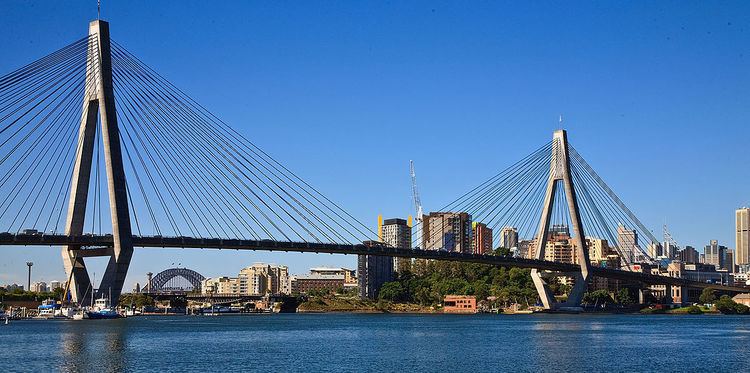Crosses Johnstons Bay Height 120 m | Official name Anzac Bridge Opened 3 December 1995 | |
 | ||
Maintained by Roads and Maritime Services Similar | ||
Heading home via the anzac bridge sydney harbour bridge
The Anzac Bridge is an 8-lane cable-stayed bridge spanning Johnstons Bay between Pyrmont and Glebe Island (part of the suburb of Rozelle), close to the central business district of Sydney, Australia. The bridge forms part of the Western Distributor leading from the Sydney CBD and Cross City Tunnel to the suburbs of the Inner West and Northern Sydney.
Contents
- Heading home via the anzac bridge sydney harbour bridge
- Anzac bridge maintenance program 2011 3d visualisation
- Glebe Island Bridge
- Anzac Bridge
- Description
- References
Anzac bridge maintenance program 2011 3d visualisation
Glebe Island Bridge
There were two bridges over Johnstons Bay before the construction of the Anzac Bridge.
The first bridge was constructed as part of a project to move the abattoirs out of central Sydney, and to construct public abattoirs at Glebe Island. The first pile of the original bridge was driven in October 1860. The bridge was opened in 1862 and was a timber beam bridge 318.6 metres (1,045 feet 5 inches) long and 8.5 m (28 ft) wide with a 12 m (40 ft) swing section on the eastern side. It replaced a double steam punt crossing.
The second Glebe Island Bridge was an electrically operated swing bridge opened in 1903, the year after the opening of the new Pyrmont Bridge over Sydney's Darling Harbour, which has a similar design. The bridge was designed by Percy Allan of the New South Wales Public Works Department who also designed the Pyrmont Bridge. Delays due to increasing traffic, which were exacerbated by having to close a major arterial road to allow the movement of shipping into Blackwattle Bay, led to the construction of the present-day Anzac Bridge. The 1903 bridge is still standing, but there is no access to pedestrians or vehicular traffic.
Anzac Bridge
The stay cable design concept development and final design for the new bridge were carried out by the Roads & Traffic Authority of NSW and the construction by Baulderstone Pty. Ltd. The bridge was opened to traffic on 3 December 1995 as the Glebe Island Bridge.
The bridge was given its current name on Remembrance Day in 1998 to honour the memory of the soldiers of the Australian and New Zealand Army Corps (known as Anzacs) who served in World War I. An Australian Flag flies atop the eastern pylon and a New Zealand Flag flies atop the western pylon. A bronze memorial statue of an Australian Anzac soldier ("digger") holding a Lee–Enfield rifle in the "rest on arms reverse" drill position was placed on the western end of the bridge on Anzac Day in 2000. A statue of a New Zealand soldier was added to a plinth across the road from the Australian Digger, facing towards the east, and was unveiled by Prime Minister of New Zealand Helen Clark in the presence of Premier of New South Wales Morris Iemma on Sunday 27 April 2008.
Description
The bridge is 32.2 m (105 ft 8 in) wide and the main span is 345 m (1,132 ft) long. The reinforced concrete pylons are 120 m (390 ft) high and support the deck by two planes of stay cables. Initially the stay cables were plagued by vibrations which have since been resolved by the addition of thin stabilising cables between the stay cables.
There is a pedestrian path / bikeway that runs along the northern side of the bridge, making possible a leisurely 30-to-40-minute walk from Glebe Point Road, down Bridge Road, over the Bridge and round Blackwattle Bay back to Glebe Point Road.
The bridge can carry a maximum of 180,000 cars per day. It reached its maximum capacity in 2002, only seven years after it was finished.
The bridge is regularly patrolled by security guards as a counter-terrorism measure. Security cameras also monitor the walkway.
The bridge has a speed limit of 60 kilometres per hour (37 miles per hour): it was reduced from 70 km/h (43 mph) in January 2005.
Originally, there were bus stops at the western end of the bridge, but they were removed because buses pulling out from the stops created a hazard as they merged with other traffic moving at (or close to) the speed limit. The Australian Anzac statue on the northern side of the bridge is adjacent to the former city-bound bus stop; the New Zealand Anzac statue was installed within the ramp area of the former stop on the southern side.
